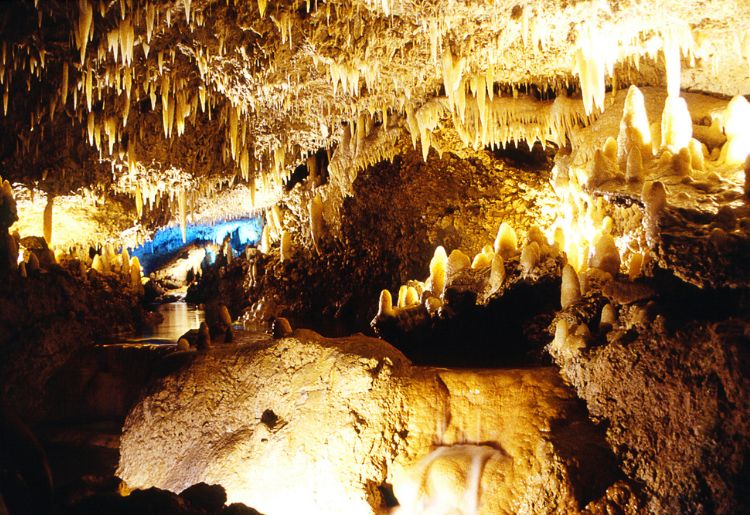Caving is a unique adventure which consists of exploring different types of caves. Also known as spelunking and potholing, caving is an extreme sport that is not for the feint hearted. In the Caribbean, you will find a variety of caving adventures for different levels of expertise abound.
Many of the countries in the Caribbean are home to a variety of caves, each with their own unique attributes and history. Some recommendations are Belize, Barbados, Puerto Rico, Bermuda, Turks and Caicos, British Virgin Islands, Aruba and the Dominican Republic.
If you are intent on exploring ancient Mayan ceremonial sites, crystal clear underground rivers and counting speleothems, stalactites, and stalagmites, you should learn the basics of caves, how they are formed, and the different types of caves.
Cave Formation and Geology
Caves are geological formations that form through various natural processes. They can take hundreds of thousands of years to form, via a complex process that involves karst and water. Caves in the Caribbean caves are primarily formed in limestone, volcanic rocks, and coral.
Limestone Caves
The most common type of cave found in the Caribbean is the limestone cave. Limestone is a sedimentary rock that is composed of calcium carbonate. Over time, water dissolves the limestone, creating cavities and passages. As the water continues to flow through the rock, it forms stalactites, stalagmites, and other unique formations.
Volcanic Caves
Volcanic caves are formed in lava tubes created by volcanic activity. These caves are found in areas where volcanic activity has occurred and are primarily composed of basaltic rock. As the lava flows, the outer layer cools and hardens, while the inner layer continues to flow. When the lava flow stops, the inner layer drains out, leaving behind a hollow tube.
Coral Caves
Caves which form in coral reefs are known as coral caves. Coral is a living organism that secretes calcium carbonate to form a hard exoskeleton. Over time, the dead coral accumulates, forming a limestone-like substance that can be dissolved by water. As water flows through the coral, it forms cavities and passages, creating unique formations.
Cave formation and geology play an important role in the study of caves. Understanding the different types of caves and how they are formed can help researchers better understand the natural processes that shape our world.
Belize
The caves in Belize are an integral part of the country’s caving tourism experiences. Thanks in part to the country’s strong Maya roots, are seen as a pathway to the Mayan underworld. These caves are often revered as sacred locations with Mayan artifacts and actual human remains. For a caving excursion with a bit of history and culture, book a tour to the Actun Tunichil Muknal, Open Air Cave or the Jaguar Paw Cave. In addition to land caves, Belize has underwater caves and sinkholes including the most popular sinkhole in the world, the Great Blue Hole.
Great Blue Hole
The Great Blue Hole is a world-famous underwater sinkhole off the coast of Belize. Although it does not fit perfectly into the definition of a cave, it is very popular with cave explorers. The sinkhole, which is more than 300 meters wide and 125 meters deep, is home to a variety of marine life, including sharks and giant groupers. The best way to experience the Great Blue Hole is by booking a scuba diving or snorkelling tour.
Cayman Islands
The Cayman Islands has several intriguing networks of caves, which are great options for potholing. There are over 100 caves throughout the islands, however, only three of them are available for public access. The Crystal Caves are limestone formations with spectacular formations, pillars, hidden rooms, and passageways. If you are new to caving, you should explore the caves with a knowledgeable tour guide or tour operator.
Puerto Rico
Caving in Puerto Rico is a full-blown experience that includes other extreme adventures such as hiking, rappelling and rock climbing. Some of the best caves to explore in Puerto are Cañon de Tanamá, Río Camuy Cave Park, Cueva del Viento, and Cavernas Las Cabachuelas. To explore some of these caves, you must be in excellent physical condition. Before you book your caving experience, discuss the activity requirements with your guide.
Rio Camuy Cave Park
Rio Camuy Cave Park is a complex cave system in the northwestern part of Puerto Rico. The cave has the world’s third-largest river, the Rio Camuy flowing through it. It is a large network of caves that is home to over 16 species of bats, underground waterways and has naturally formed sinkholes. These limestone caves, which contain evidence of Puerto Rico’s inhabitants were formed by Camuy River. The Rio Camuy Cave Park is open Wednesday through Sunday from 8:00 a.m. through 3:00 p.m. AST, and reservations are required.
Dominican Republic
Caves in the Dominican Republic are windows into the country’s history. They are the spaces that were once inhabited by Taino natives who took refuge in the caves and performed rituals. Some of the caves, such as the Ancient Taino caves are for skilled cavers with an active level of fitness. There are at least 18 accessible caves in the country, and many of them have centuries-old petroglyphs and pictographs.
Los Tres Ojos National Park
Los Tres Ojos is a series of three interconnected limestone caves located in the eastern part of the Dominican Republic. To enter, you must descend on a winding staircase that leads to a series of caves with blue lagoons, a series of caves, pottery shards and petroglyphs. These caves are five meals east of Santo Domingo and are protected by the Los Tres Ojos National Park.
Barbados
Barbados has several inhabited and uninhabited caves. The top three options for exploration are Coles Cave, the Animal Flower Cave and Harrison’s Cave. However, the most popular of them all is Harrison’s Cave. Harrison’s Cave is a limestone cave located in the central part of Barbados, in the parish of St. Thomas. It is part of the Chukka experience, which is ideal for extreme sports people. The cave itself has deep pools of clear water, flowing streams, glistening formations, and towering columns.
Bermuda
Bermuda’s best known caving systems are often described as “dramatic”. The Crystal Caves and the neighbouring Fantasy Caves are limestone caves located in the northeastern part of Bermuda. Some of the stunning features of the caves are stalagmites, waterfalls, and a floating bridge over a beautiful lake. When buying tickets, remember to ask for a combination ticket which gives entry in the Crystal Caves and the Fantasy Caves.
British Virgin Islands
Travellers to the British Virgin Islands, should add a caving trip to their itinerary. The islands have a few caving systems, but the most popular is the Norman Island Caves. The caves are a series of underwater caves which are accessible by water only. Located on Norman Island, the caves are believed to be the inspiration for the Treasure Island book for Robert Louis Stevenson. Because Norman Island Caves are accessible by water only, they are popular for snorkelling and diving excursions.
Turks and Caicos Islands
There are many caves in the Turks and Caicos Islands, many of which were created by the Karst system. Karst occurs when natural features, including caves are formed through dissolving bedrock. Throughout the islands, there are dry caves – found on land; underwater caves – found in water; sinkholes, and blue holes.
Conch Bar Caves
The most popular cave system in the Turks and Island is the Conch Bar Caves. It is is a series of limestone caves located in the Middle Caves. It is a Karst limestone cave system with a variety of geological formations, including stalactites, stalagmites, and underground rivers. The best way to explore this cave is to take a guided one-hour tour. Conch Bar Caves are open Monday to Friday, 9:00 AM to 3:00 PM, and Saturday from 11:00 AM to 3:00 PM.
Aruba
The caves in Aruba are consist of unique geological formations, including stalactites, stalagmites, and underground rivers. You can take a guided tour of the caves to explore their beauty and learn about their history. They are open to the public between 8 am and 4 pm.
Fontein, Quadirikiri and Huliba Caves
The most popular caves in Aruba are located on the windward side of the island. The big three caves, the Fontein, the Quadirikiri, and the Huliba caves are limestone formations with intriguing recesses and chambers. The Fontein is the most popular of the three, because it has preserved drawings by the Arawak Indians on the ceilings.
Jamaica
The caving experiences in Jamaica are more than just extreme adventures. They are activities that focus on the historical, cultural, and natural significance of their specific locations in the country. The best caving in Jamaica is in Cockpit Country, Bunker’s Hill, and Green Grotto.
Caribbean Caving Tours and Expeditions
A caving expedition if a great way to explore the hidden underground world of the islands. Here are a few guided and self-guided options for caving tours in the Caribbean:
Guided Tours
Guided tours are recommended for those who are new to caving or want to learn more about the caves and their history. These tours are led by experienced guides who know the caves and their surroundings well. They will take you through the caves and point out interesting features such as stalactites, stalagmites, and underground rivers. Some popular guided caving tours in the Caribbean are:
- The Wonders of Turks and Caicos Cave Expedition
- The Caving Adventure in Curaçao
- Harrison’s Cave Adventure Tour in Barbados
- Actun Tunichil Muknal Cave Tour in Belize.
Self-Guided Adventures
For those who prefer to explore on their own, self-guided caving adventures are ideal. With a self-guided tour, you can explore at your own pace. Some popular self-guided caving adventures in the Caribbean are:
Flora and Fauna of Caribbean Caves
When you explore the caves in the Caribbean, you can get a glimpse into their unique ecosystems. Caves are home to a diverse range of flora and fauna that have adapted to the dark, damp, and often harsh conditions found underground.
Endemic Species
Many of the species found in Caribbean caves are endemic, meaning they are found nowhere else in the world. For example, the Jamaican cave cricket is a unique species that has adapted to life in the dark caves of Jamaica. It has long antennae and large hind legs that allow it to navigate the rocky terrain of the caves. Other endemic species include the Puerto Rican boa, which is a non-venomous snake found in the caves of Puerto Rico, and the Cuban cavefish, which has no eyes and has adapted to life in the dark caves of Cuba.
Biodiversity and Ecosystems
Caribbean caves are also home to a wide range of other species, including bats, spiders, insects, and crustaceans. Bats are perhaps the most well-known inhabitants of Caribbean caves, with many species using the caves as roosting sites. In addition to providing shelter for animals, Caribbean caves also support unique ecosystems that are not found on the surface. For example, cave ecosystems often have their own food chains and nutrient cycles, with bacteria and fungi playing important roles in breaking down organic matter.
Caving Equipment and Safety
Although many of the more popular caves in the Caribbean have been updated for easy access and exploration, there are some gems that are as natural as they come. For this type of caving, you will require proper equipment and adhere to safety protocols. Here are some essential gear, safety protocols, and cave conservation practices to keep in mind when exploring caves in the Caribbean.
Essential Gear
The right gear will keep you safe and comfortable as you journey through cave systems. At the minimum, you should consider travelling with:
- Helmet: A helmet is one the most important caving accessories because it will protect your head from bumps and falls.
- Headlamp: A headlamp will allow you to see where you are going. It is especially useful in dark caves there is no light. Also, remember to pack extra batteries.
- Gloves: When caving, you should wear gloves to protect your hands from sharp rocks and other hazards.
- Boots: Always choose sturdy boots with excellent traction that will allow you to easily navigate wet, slippery, or uneven surfaces.
- First Aid Kit: A well-stocked first aid kit, will provide immediate relief in the event of any injuries sustained when caving.
Safety Protocols
Caving can be dangerous, so you must put your safety first. Bear these safety protocols in mind:
- Never cave alone: Even if you are an expert, do not venture into caves by yourself. Always explore caves with a group of at least four people. If something happens to you, there will be someone to help you.
- Stay together: Do not wander away from your group when exploring. Always stay together and do regular checks on group members.
- Communicate: Create a communication plan that includes hand signals and verbal communication for the group.
- Know your limits: Whilst it may be tempting to go as far as you can, only explore caves that are within your skill level and experience.
- Be prepared: Always be prepared for emergencies. Bring extra gear, food, water, cell phone, candles, lighters and matches.
Cave Conservation Practices
Cave conservation refers to the practices that help to protect and restore caves and minimize harmful impacts which may be caused by natural and human activities. Caves are home to many species of wildlife and microbes and may contribute to clean water and water availability. As a result, when caving in a developed cave or a raw cave, there are some basic cave conservation practices to follow:
- Stay on designated paths: To avoid damaging the cave environment when exploring, always stay on designated paths.
- Leave no trace: Practice minimal impact caving and pack out all trash and waste and leave the cave environment as you found it.
- Respect wildlife: You can observe, but do not touch or disturb any wildlife you may encounter in the cave.
- Report damage: If you see any signs of damage or vandalism in the cave, report it to the appropriate authorities.
Caving Courses and Certifications
If you’re serious about caving and want to learn more about caving and cave conservation practices, you should consider pursuing a course or certification. These courses will teach you the skills and techniques you need to safely explore the caves. Some popular caving courses and certifications are:
National Speological Society: Caving Education and Awareness
British Caving Association (BCA): Local Cave and Mine Leader Assessment (LCMLA)
Lost Earth Adventures: Beginner, Intermediate and Advanced Caving Courses
NCKMS Steering Committee: National Cave & Karst Management Symposium
Dominican Divers: Cave Diver Course
National Cave Rescue Commission: Orientation to Cave Rescue (OCR)
ProVenture: Accredited Instructor Courses for Leaders of Adventure Activities
Canmore Cave Tours: Intro to Cave Survey
Dolomite Training: Caving Intermediate Course
Caving Academy International: International Caving Courses
Frequently Asked Questions
Here are a few FAQs about caving in the Caribbean:
What are the top caving destinations in the Caribbean?
Some of the top caving destinations in the Caribbean are Belize, the Turks and Islands, Bermuda, the Cayman Islands, Barbados, the Dominican Republic, and the British Virgin Islands.
Which Caribbean islands have memorable cave formations?
Some of the most memorable cave formations in the Caribbean are Harrison’s Cave in Barbados, the Green Grotto Caves in Jamaica, and the Cueva del Indio in Puerto Rico.
Are there guided caving tours available in the Caribbean?
Yes, there are many guided caving tours available in the Caribbean. Tours will teach you about the history and geology of the caves. The best caving tours provide all of the equipment needed and are led by experienced and knowledgeable guides.
Is cave tubing offered in the Caribbean?
Yes. Cave tubing, a popular activity which involved floating on waterways inside caves on an inflatable tube, is available in Belize, Jamaica, and the Dominican Republic.
What is the best time of year to go caving in the Caribbean?
The best time to go caving in the Caribbean is during the dry season, which typically runs from December to April.
Are there any cenotes in the Caribbean?
Yes. Cenotes, which are natural sinkholes in limestone, are found in Belize. They are the Great Blue Hole and St. Herman’s Blue Hole.










